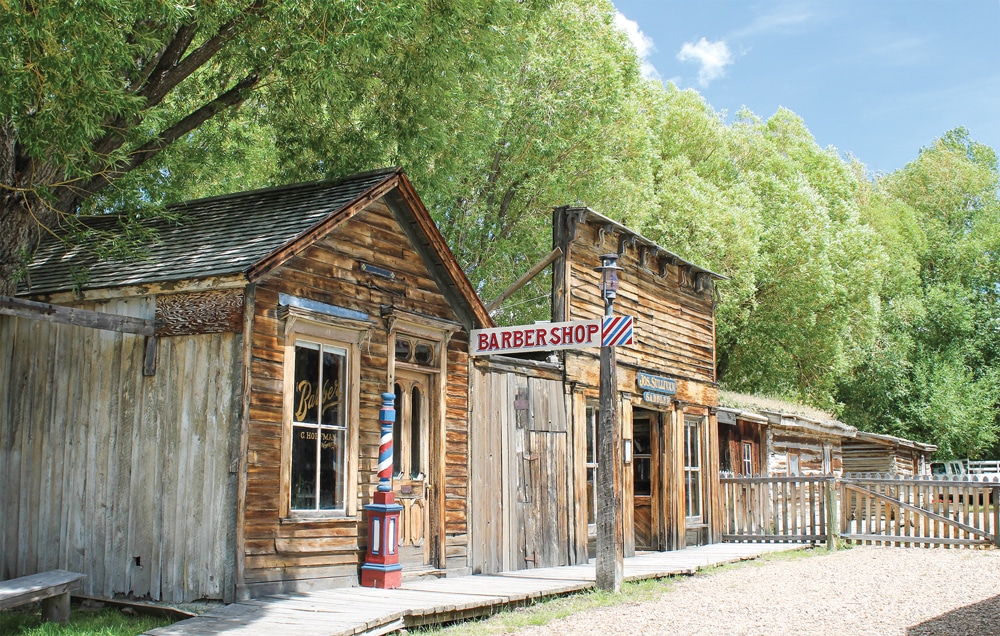Experience the excitement of Montana’s gold rush in these two historic Old West cities frozen in time
Back in the mid-1800s in the American West, towns sprang up at the mere whisper of the word “gold.” In 1862, Bannack (now a  ghost town in Montana) was the site of the earliest significant gold discovery in what would soon become Montana Territory. Five prospectors, led by William Fairweather, lost interest in Bannack and searched for gold along the Yellowstone River. Crow Indians turned the men back.
ghost town in Montana) was the site of the earliest significant gold discovery in what would soon become Montana Territory. Five prospectors, led by William Fairweather, lost interest in Bannack and searched for gold along the Yellowstone River. Crow Indians turned the men back.
The prospectors headed through the Madison Valley back to Bannack, planning to restock supplies and try their luck again. On May 26, 1863, they camped near a gurgling stream thick with stands of alder. To the south of the gulch Mount Baldy rose; to the north, the Tobacco Root Mountains. The men pulled out their prospecting tools and before darkness fell, they had found a major gold strike. Staking the claim in what they named the Fairweather Mining District, they called the place Alder Gulch. They rode on to Bannack, agreeing to keep their gold a secret. Henry Edgar, one of the prospectors, wrote in his diary that total strangers in a saloon were already “… telling we brought in a horse load of gold.” After filing their claims, the men tried to slip out of Bannack, but soon realized at least 200 prospectors followed them. On June 6, 1863, the group arrived at the site that would become Virginia City. The Fairweather prospectors convinced the gold-hungry men that they had filed legal claims. To their credit, the crowd calmed. Nevertheless, the Montana Gold Rush was on. Within a few months, 10,000 gold seekers crowded into a 14-mile stretch in Alder Gulch, seeking their own claims. Above Virginia City, four settlements sprouted; below, three more, including today’s reproduction of Nevada City. Virginia City, the largest of the communities, stands as a footprint of the past frenzied days when fortunes were gained – and lost.
The boomtown drew prospectors, but also merchants, ladies of the night, schemers, outlaws, citizens of many nations and members of numerous religious groups. Men and women from every social class and economic status flocked to Virginia City, and soon, miners became a minority population.
Within three weeks of the Fairweather gold strike, Virginia City was planned and platted as a permanent community with straight streets and square corners. The city transitioned from a chaotic mining camp of mud huts, tents and lean-to shacks to an organized town. Storefronts went up and some residents built Victorian-style homes. While the early days sound exciting, daily life was difficult and dangerous. Human comforts were few. Days were dull and filled with mundane chores of existence.
Violence and crime followed the money being made in Virginia City. Daily, miners and merchants suffered robberies, beatings, lootings and murders from lawless individuals drawn to the area. A local vigilante group formed. Today, stories conflict about its motives and its success. However, a few men were determined to bring law and order to the area with their motto: “Do your duty, men.” Outside Virginia City on Boot Hill, graves of hanged road agents mark the rough and dangerous times – and the determination of the vigilante group – in Virginia City’s early days.
Fairweather, for whom the Fairweather Inn is named today, led his prospectors to fortunes, but in the end, only one of the six invested his gold into a thriving business. Fairweather died penniless in Montana at age 39. In beginning days, the Fairweather Inn housed the Anaconda Saloon. The proprietor prepared for all occurrences by storing a casket in the building’s basement. Today, the Fairweather Inn is a popular overnight lodging choice in Virginia City.
The city grew rapidly and within a few years of its establishment, merchants and businessmen outnumbered gold miners. Signs on storefronts boasted general merchandise, jewelers, bakeries and furniture. Services such as ox and mule shoeing, legal advice, restaurants, saloons and overland stage transportation were available.

Those who visit Nevada City, Montana, during the weekend can interact with living-history interpreters such as Harlan and Joal Olsen.
Many of the buildings, like the Fairweather Inn, started as one business, and then transformed into another. Sauerbier Blacksmith Shop began as a notorious dance hall in 1863. The building encompasses a small V-notched log cabin, one of the first buildings in Virginia City. Tall French doors and a few dentils still cling to the façade, recalling its former days. Charles Sauerbier and his son converted the building to a blacksmith shop in the 1870s and operated their business until the 1940s. In the early years, they repaired stagecoaches and shod ox teams that pulled huge freight wagons of goods into the city.
The old buildings lining board sidewalks, most of them original to the town, owe their continued existence partly to Montana’s dry climate. However, the major credit goes to Charles and Sue Bovey, Montana citizens who directed their energy and financial resources to preserve the old town. Today, Virginia City is a National Historic Landmark and is listed in the National Register of Historic Places.
Charles Bovey, one of the heirs to a milling corporation, later known as General Mills, grew up with the advantages of education, travel and a position in his father’s business. However, Bovey found his niche in ranching rather than flour milling. He married a Montana girl, Sue Ford, and together, they fed their passion for Western history by starting a collection of old Montana buildings and artifacts. As a Montana House representative, and later as a state senator, Bovey worked to create pubic awareness of the preservation of old buildings and communities.
John Ellingsen, a curator of Virginia City and Nevada City, and author of “Witness to History: The Remarkable Untold Story of Virginia City and Nevada City, Montana,” worked closely with the Boveys for two decades. He writes that Bovey said he knew when he first entered Virginia City that the place was a national treasure. He and his wife recognized the downtrodden and mostly abandoned buildings presented a unique opportunity to preserve an entire town and the eras of history it represents. On their first visit, they witnessed boards being pulled off the old structures for firewood or scrap lumber. Timing to restore and preserve the town was crucial. Bovey, with the help of historians and other citizens, formed the Historic Landmark Society of Montana. Bovey himself bought many of the important Virginia City buildings. Soon, he owned more than 100 houses and shops, including the Bale of Hay Saloon, Buford Store, the Judge Blake House, the Hangman’s Building, and the Gilbert house and brewery.
Ellingsen remembers Bovey as a “hands-on” man, working tirelessly on restoration and becoming acquainted with every board, beam, shingle, brick, stone, nail and dowel in Alder Gulch. The old train depot at Nevada City displays information and memorabilia about the Boveys.
While Virginia City is an authentic town with restored original buildings, Nevada City – only 2 miles down the road – is a fictional historic town, reproduced on the original plat of the city, but with buildings brought in from other parts of Alder Gulch and Montana. On weekends, costumed interpreters live in Nevada City. Some act out scenes of the past with arguments in a saloon over a boxing match; others go about the daily chores of baking, laundry, spinning, sewing and even teaching the school children of Nevada City.
Buildings along the highway are original, including the Star Bakery Restaurant. The reproduced city behind the row of original buildings requires an admission ticket. Entrance is through a museum of music machines that once filled the front room of the Bale of Hay Saloon in Virginia City, a place where even kids were welcome. The old saloon operated until about 1908, and then stood empty until 1945 when it was restored by Bovey. He added rare music machines to his player piano collection, but a fire in 1983 badly burned many of the machines. Some were restored in other parts of the world and stand today in the museum at Nevada City. The Bale of Hay Saloon in Virginia City remains much as Bovey found it, except for the ornate 1880-vintage bars, which were brought from Benchland, Montana.
The dirt streets of Nevada City are lined with various structures, mostly modest, unpainted dwellings and cabins. One two-story white house, obviously owned by an affluent family, was the home of Montana’s first politician. An interpreter, seated on a bench outside the fence with a basket of mending, told of tragedy in the household – the deaths of a wife and young daughter, and eventually, the father. The house is elaborately furnished, although dusty with age. Many claim the old home is haunted.
The livery building in Nevada City, once the dining hall at Canyon Village in Yellowstone National Park, displays various conveyances used in the area during the mid- to late 1800s. Interpreter Harlan Olsen points to an old milk wagon, tour wagons at Glacier National Park and enclosed family carriages. The livery also holds parts and pieces from an old carriage company once located in Butte, Montana. Olsen and his wife, Joal, spend weekends in a primitive cabin on one corner of the old city, acting as interpreters.
Without the Boveys’ commitment to preservation, visitors today could not stroll the boardwalks of Virginia City or the dirt streets of Nevada City. There would be no stores filled with merchandise of long ago, no musical sounds from the Opera House, no restaurants occupying old buildings and no Alder Gulch Train running between the two cities. Both historic towns are places to visit again and again, letting imaginations fly back to 1863 when the mere mention of gold started prosperous new cities.
For More Information
Montana Heritage Commission
406-843-5247 | www.virginiacitymt.com
Virginia City
www.virginiacity.com








